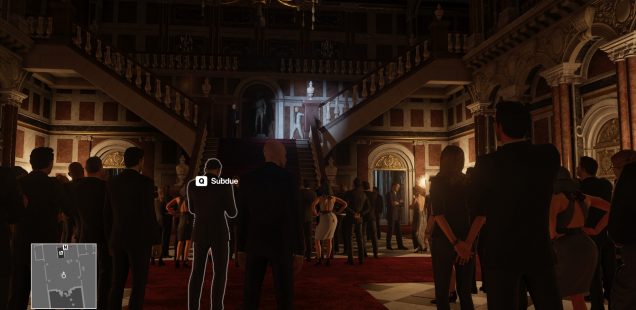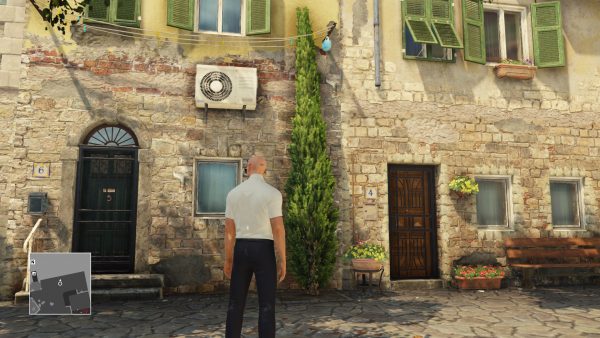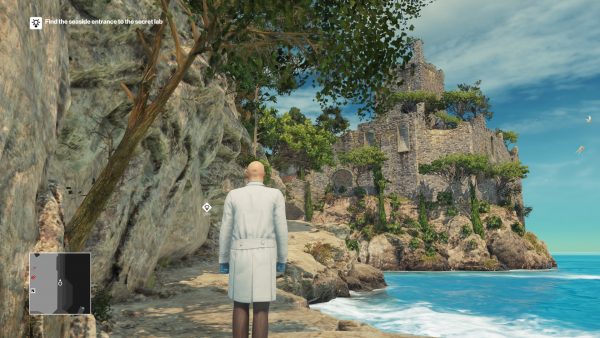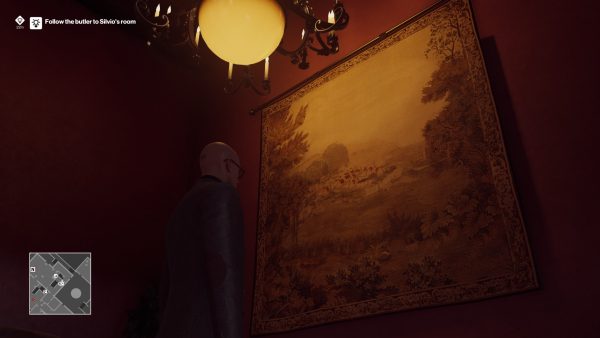
The Language of Level Design in Hitman
Bartłomiej Musajew shows off.
As you enter the palais, a man in a white suit starts to strut down the imperial staircase with an air of insouciance, feigning indifference to the bluish spotlight trained on him like a rifle barrel. The carpet under his feet is carmine, the color of dried blood. A statue of Napoleon Bonaparte looming in the niche behind him, he stops on the landing and spreads his arms to acknowledge the crowd gathered in the foyer; if he raised them a little higher, he would resemble the captive in Goya’s The Third of May 1808, imploring the firing squad to spare him. This is Viktor Novikov, your target, a Russian oligarch using his fashion house, whose Paris show you are attending, as a front for more devious schemes. An atmosphere of refined opulence – created by rusticated walls, bonneted dormers, a lantern with a mounted tricolor flag, fleur-de-lis designs, gilded pilasters, mahogany chairs on cabriole legs, marble-topped guéridons supported by caryatids, and a fountain with urinating putti – is mixed here with a vague, yet all-pervading, sense of menace that cannot be repressed.
I bet this is not the first time you’ve encountered a writer showing off their knowledge of literary gimmicks. I may have even made some of this up, counting on your inattentiveness. Is the carpet in the described scene really carmine? To be honest, I don’t know; it looks dark red to me. I just Googled the color of dried blood in order to link the carpet with the theme of murder. I guess I can always rely on the fact that color perception is, to an extent, subjective. Furthermore, color terms don’t have precise referents, and it all depends on the light anyway. Is the spotlight really bluish? That’s why I used the softening -ish. I can always say there is just a tinge of blue in it that I see it because I’m more perceptive than you. If I were a respected art critic, you would probably see pink there if I told you to (or at least you would give me the benefit of the doubt, distrusting your own eyes). And there is no intrinsic struttiness to Novikov’s gait, it’s just my impression. Besides, doesn’t strutting, implying excessive care for appearances, preclude insouciance, which means the opposite? How can I ascribe both qualities to a single act of walking? Who cares, it’s just an article about a videogame. As long as it sounds pretty, I should be fine. Finally, Hitman (2016), as the title indicates, is about killing people, so there’s no need to transform the explicit theme of assassination into a sense of menace evoked by the setting. The player needs to off the guy while avoiding armed guards, there is no je ne sais quoi to it.

Obviously, I’m exaggerating for the purpose of demonstration, but such techniques are used in various forms in all kinds of writing. One could argue that, as ornamentation, they are of no consequence. Well, not exactly. I have sublimated the undeniable act of walking – the motion of a solid body through space – and the undeniable danger accompanying assassination to the gaseous form of airs, atmospheres, tints, and tinges. I’ve reduced objective truth to subjective impressions. Instead of describing by situating objects in space, I’m connoting visuality, descriptiveness, and literariness by enumerating specialist and foreign-sounding terms. In fact, I’ve denied the reality of the scene by aestheticising it. This is just a text about a videogame, but the use of words for purely connotative purposes may have more pernicious consequences. For instance, it is easy to mistake big names and words ending with -ism, connoting scholarliness, for actual comprehension of a given subject. As for the less refined uses of language, the enjoyment of slang, dialect, and cultural references in popular culture may crystallize into stereotypes or instill a sense that language, origins, and self are inextricably bound up, in this way facilitating racist or nationalist attitudes. Finally, what seems like political awareness usually turns out to be merely a nebula of proper names, associations, and affects, a situation the media are eager to perpetuate and exploit.
The purpose of my exercise in bad writing is to mirror the functioning of architecture and interior design, which signify by connotation, thus being a perfect tool for manipulation and obfuscation. But because of their signification, they can also be used in level design to help articulate specific themes. There is a reason that this particular mission takes place in a Parisian palace. The theme of this level’s narrative is the performance of power. Both Novikov and his associate, Dalia Margolis, put their dominance over the fashion market on display, while at the same time concealing their true agenda as members of a spy ring. French architecture and visual arts themselves have come (in part because of their connection with absolute monarchy or, in the 19th century, with urban renewal programs overseen by Georges-Eugène Haussmann) to be associated with the impression of opulence and grandiosity without referring to the actual realities of exploitation and control. For instance, this explains why representations of Napoleon Bonaparte – whose reign was embodied by the Empire style in architecture, design, and visual arts – are scattered throughout the level. Instead of looking at the level design in terms of realism, as the dominant way of thinking about games as technologically advanced representations of real objects and processes would have it, we should read it as an expression of a theme.

Now I’d like to demonstrate this thematic aspect of level design in more detail with a different example. In Sapienza, a fictional Italian hilltown by the sea, both the narrative and the level design revolve around the theme of the cultural encoding of nature. This mission’s story concerns the development of a virus that can be adjusted to a specific person’s DNA, spreading undetected until it reaches its target, whom it inevitably kills. The DNA metaphor, which treats nature itself as a language with its own syntax and vocabulary, is thus combined here with the theme of synthetic manipulation of the natural world; the virus politicizes nature, turning it into a tool fit for use in human conflicts, but also naturalizes politics by disguising human agency as the workings of natural forces. Furthermore, the in-game profile of Silvio Caruso, the head of the project, suggests that his interest in biological weapons may have resulted from the relations with his overbearing mother, serving as a means of asserting control. By juxtaposing two pieces of information, the same profile establishes a link between Caruso’s mother’s being found dead in her bed, seemingly due to natural causes, and his being contacted by a company with the uncannily apt name of the Ether Corporation, alluding to the substance used as an anesthetic. During the mission, Agent 47 can disguise himself as a psychotherapist and, after hearing out Caruso’s confession about killing his mother, reenact this act of murder by – I think the pun was intended by the game’s creators – smothering his target with a pillow. This subplot, infused with the ether-filled, suffocating atmosphere of a family dynamic based on domination, implies that complex corporate and political decisions can be put down to relations with one’s mother – relations coded as primal, located on the threshold between nature and nurture.
It’s not a coincidence that this mission is set in a small Italian hilltown. The Mediterranean, from the Western point of view, has the almost mythical status of the cradle of European culture, thus being inextricably tied with the notion of origins. This setting thus evokes the tension between the primal, nomadic state of early mankind and the beginning of Western civilization, but also the overtaking of this civilization by supposedly barbarian peoples considered equal with uncontrollable natural phenomena. Significantly, the action does not take place in Rome, Venice, or Florence – associated with the supposed zenith of civilization’s development – but in a small coastal town, whose architecture is meant to connote vernacularity: being determined by natural site, and sprouting from communal endeavor as opposed to abstract ideas and institutional planning. The streets of Sapienza are lined with buildings whose ground floors, with unplastered stone facades, contrast with the brightly painted upper floors. This contrast fulfills two functions. First, it inscribes the site in the buildings, thus embedding them in the hillside, as if they were rocky outcrops formed by natural processes, and not products of human industry. Secondly, it highlights the effort necessary to preserve the upper floors against natural forces. This effect is amplified by the peeling of paint off several walls and the presence of a ruined fortress in this level, which prefigures the future disrepair of the buildings. Sometimes, this peeling reveals brick, which may be treated as an ironic commentary on the falsity of the attempt at representing architecture as part of nature. Seen from the harbor, the town, crowned with a round dome alluding to the sinuosity of the landscape, blends with the hills in the background, which, albeit unreachable, are a constant visual presence.

The player cannot reach the hills beyond the town, several signs indicate their existence as the natural site of the town’s development. For instance, the last arch of an exterior arcade punctures a cliff, a reminder of the effort needed to carve the passage out of rock. Beside this arch, there is an entrance onto a natural ledge running along the cliff face, which has been appropriated as a privately owned path for Caruso’s research team. This path leads to a secret lab located in a system of caverns – prefigured by the arcaded passage – with stalactites hanging from the ceiling. The caverns open out onto the sea, Caruso’s seaplane being located near the opening. The setting of the laboratory inside the caves, and the visible appropriation of natural features by private and corporate interests thus parallel the development of a biological weapon treating nature as a freely configurable code.
Finally, in Caruso’s mansion above the caverns there are paintings and tapestries representing the interaction between nature and culture. The common motif of the artworks is the integration of human-built structures with the landscape. In two of them, the observer looks at a fortified coastal town from different perspectives: one located along the coast with trees taking up the left half of the painting, the other on the hills above. A similar motif is repeated in a tapestry, where the perspective is again that of an observer looking from above at a walled town, with trees at the periphery of their vision. In another painting, the observer looks from a rooftop at a square, with a tree in the middle, in front of a mansion, like the one the player is visiting at this particular moment. The art pieces can be said to form a story of a barbarian intruder, associated with nature and having their field of vision limited by trees, getting gradually closer to a civilized town, finally to infiltrate it and see nature, represented by a tree, encircled by civilization.

To wrap things up, here is a short summary of how this thematic aspect of level design functions in the rest of the game. In Marrakesh, where the player has to kill a banker holed up at the local Swedish consulate, the theme is the destabilization of national governments and local cultures by the global flow of capital. Much of the level is taken up by a marketplace, where rugs, spices, and elaborate silverware, the stereotyped signs of the exotic, vie with Western merchandise, plastic furniture, and air conditioners. In a private militia camp located on a Colorado farm, red barns with gambrel roofs – evoking communitarianism, American Midwestern and Western rural ideals, and colonial America associated with citizen militias – emphasize the paradox that, in the globalized age, political and military action is strongly localized, assuming communal or even tribal dimensions. In Bangkok, the targets are an English lawyer and his New York client visiting a hotel with a staff trained in extreme servility. The greenhouse architecture of the lobby – reminiscent of 19th-century shopping arcades, railway stations, and world’s fairs, all linked with international trade enabled by colonial rule – highlights the persistence of imperialist habits. In Hokkaido, Agent 47 has to eliminate a traitor, whose act of betrayal is juxtaposed with inverted internal organs; the direct causality implied by this juxtaposition merges medical knowledge with folk belief. The sharp lines and the immaculate tidiness of the high-end clinic, where he is to be operated, contrast with lanterns, Buddhas, and cherry trees, which connote the oriental and the spiritual, reminding us that, in the age of occult expert knowledge accessible only to a caste of priest-like specialists, science becomes the new religion. All this proves that particular levels are not just realistic stage sets – a mere background for gameplay – but that they help reinforce specific meanings conveyed by the narrative.
Bartłomiej Musajew is a PhD student interested in literature and videogames. He lives in Warsaw, Poland.